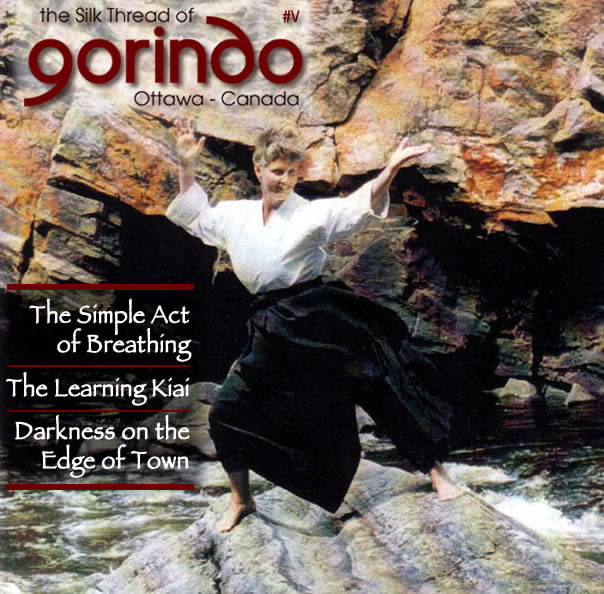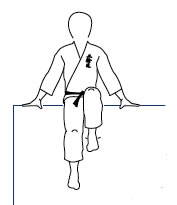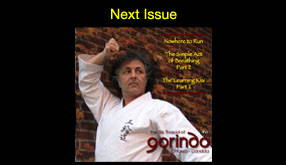
The Silk Thread of Gorindo - Ottawa - Canada
Issue V
- The Simple Act of Breathing (Part 1)
- Darkness on the Edge of Town
Photo cover Roxanne Standefer sensei, Gorindo School of Martial Art
The Learning Kiai (Part 1)

In martial arts, the beginning white belt wants to move like the expert and the black belt wants to recreate the freshness of the beginner. Most people, young and old, get very excited when they begin studying martial arts. They want to learn everything at once, train every day, and practice at home in front of the mirror. There is a powerful energy associated with learning something new; it makes people feel good about themselves and more open to others. Although there is a lot to learn in the martial arts, and it can seem confusing at first, the white belt is taking the first steps in the Kiai; identifying themselves within their own body and their role in the learning process.
The method of acquiring knowledge in the martial arts is very structured. The beginner, intermediate and advanced student have a special place and specific goals and responsibilities. In a good school, the beginner is treated with respect, and although they may line up at the back of the class, it is so they can see and follow the movements of the advanced students ahead of them. Everyone was a white belt at one time, and the attitude of those who have moved a bit further along the path should always be helpful and encouraging, never demeaning. After all, the only real difference between them is who saw the poster in the street or the advertising in the phone book, first.
There is equal opportunity for those beginning the study of martial arts and progress will be measured individually. Everyone learns at different speeds, and that can depend on how much time one can devote to training and practicing, the fitness level of the individual, and more importantly, the attitude about learning.
Many modern styles of martial art employ a colored belt system to mark the progress of a student through the “ranks.” In the goal-oriented Western cultures we have readily accepted this structure, and people work very hard to “change their belt” through testing and examination sessions called “gradings.” However, it is important for the student to keep in mind that the colored belts exist to standardize the order in which techniques are taught. For the purposes of evaluation the belts are not awards for accomplishments, but merely indicators of where within the system the student is working. When the belt color is changed it lets everyone in the school know what material the student is now ready for, but does not imply that he has fully mastered everything that has come before.
This is an important distinction between the martial arts and many other sporting traditions, and is related to the culture from which they have evolved. In the more traditional Eastern martial arts, there are often only white belts and black belts, and sometimes a brown belt to indicate a candidate for the black belt examination. In earlier times, when schools or ryu were organized around a single master or sensei, students trained in the courtyard of their teachers’ home, or in the village square. They wore simple loose clothing, gathered about the waist with a sturdy belt of cloth, and although these garments were washed frequently, the belt became more stained with the sweat of exertion and ground-in dirt. The more a student trained, the dirtier and darker their belt became. Senior students were eventually recognized by the color of their belt, but had no illusions that what they were wearing was anything more than a “dirty white belt.” When beginners learn of this tradition, they are less embarrassed by their white belt status in the class and look forward to the learning ahead of them.
Excerpt from “Martial Arts Mind & Body” by Claudio Iedwab & Roxanne Standefer. See also their e-books available at askSensei.com >>
Illustration by © Claudio Iedwab
- The Simple Act of Breathing (Part 1)
- Darkness on the Edge of Town
« Click the Subscribe link on the left




